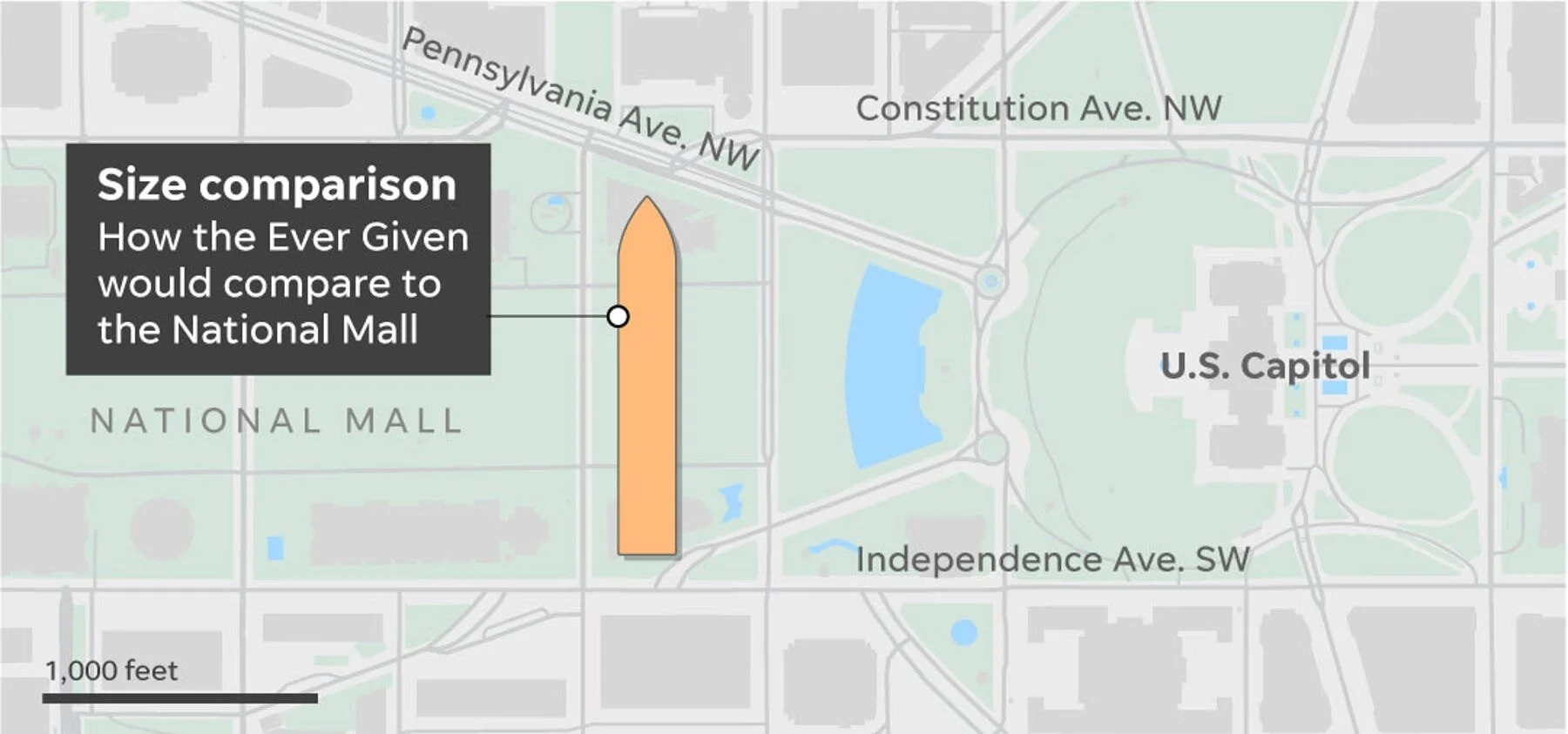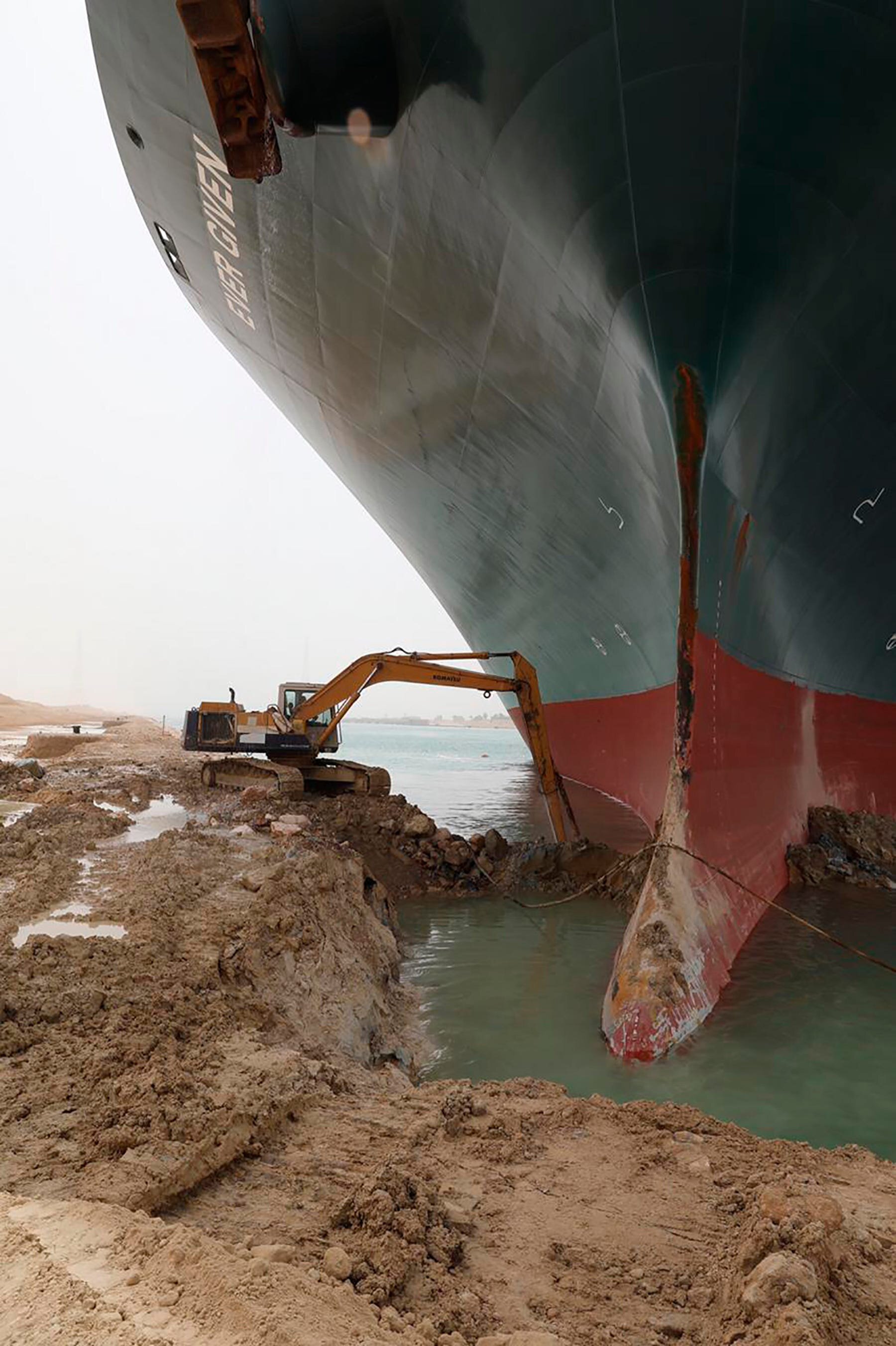The Ever Given
Have you all seen the news about the boat that’s been stuck in Egypt’s Suez Canal? It’s a big boat. Actually, it is a huge boat that is longer than the Empire State Building is tall and as tall as the National Mall is wide in D.C. If not, let me give you a little bit of a rundown on the situation.
The boat, which is called the Ever Given, is a massive container ship that is operated by the Taiwan-based shipping company Evergreen (Mull, 2021). It is stuck in a single-lane section – about 985 feet wide – of the canal about 3.7 miles north of the canal’s southern entrance. Originally, the ship’s owners said, “high winds in a sandstorm pushed the ship sideways, wedging it into both banks of the waterway” (Petras et al., 2021, para. 9). Now, however, there is some speculation that there may have been technical or human errors that lead to the boat’s sticky situation. Regardless of how it got stuck there, this ship has caused some serious problems. As stated by Petras et al. (2021), “at least 360 ships, carrying everything from cars to oil to grain, wait at the canal’s northern and southern entrances…some ships have already diverted to the African route” (para. 11). The alternate route around Africa’s Cape of Good Hope is not only much longer than through the Suez Canal, but there are also increasing fears about piracy. On Monday, March 29th, the Ever Given was completely freed by a team of tugboats, a dredger and apparently, the rising tide.
So, why am I telling you all about the situation with the Ever Given? Well, “the canal is a 120-mile-long shipping link between the Mediterranean and Red seas that carries 10% to 12% of commercial shipping and about 2.5% of the world’s oil” (para. 13). Strategically and economically, it is “one of the most important waterways in the world” (para. 14). In fact, it is estimated that delays could cost global trade $6 billion to $10 billion a week. To give a little context, the Ever Given was stuck for about a week; and, it is estimated that its effects will be felt for quite some time after. Here’s the interesting thing – as expressed by Amanda Mull (2021) for The Atlantic:
I’m obsessed with the dang boat because people like me and you are not really supposed to be aware of what boats like her are up to. You’re not supposed to think about, or even notice, global freight, but the Ever Given has made cartoonishly noticeable some of the crucial infrastructure of global capital, which is usually invisible in most people’s daily life. (para. 5)
Mull (2021) continued:
A significant portion of your material possessions, including virtually everything you’ve ever bought from Amazon or Best Buy or Target or Walmart, was ferried most of the way from where it was manufactured to where you bought it on a ship similar to the one currently taking an extended smoke break in the Suez. (para. 7)
My thesis research centered around the idea of onshoring or nearshoring supply and production practices as a way to decrease the luxury industry’s environmental impact. In the simplest terms possible, what I found is that onshoring or nearshoring is more complicated than it seems due to the industry’s longstanding and complex global supply chain; but the Ever Given has pretty blatantly shown the complications of offshoring supply and production. First of all, have you noticed some of your packages taking longer and longer to arrive? Well, that’s likely because of the Ever Given’s “extended smoke break” holding up international shipping. Second, corporations shift supply and production offshore because it’s so much less expensive and there are relaxed labor laws in other parts of the world. But, as Mull (2021) effectively explained:
When people have to think about [global shipping]—and perhaps, as a result, feel connected to the high-stakes logistical ballet that is global manufacturing, or implicated in the often miserable working conditions of the faraway people who make it possible—something consumer psychologists call ‘friction’ is introduced into the buying process. (para. 9)
Basically, what you don’t know won’t hurt you… and now, it’s impossible not to know.
As it pertains to the fashion industry, when you shop from companies like SHEIN, H&M, boohoo or, honestly, Amazon, the clothing is coming to you via ships like the Ever Given. Maritime shipping hugely contributes to the fashion industry’s environmental impact, including air pollution, greenhouse gas emissions, release of contaminated water into the ocean, oil and chemical spills and more. This giant ship’s sticky situation forced us all to acknowledge just how much we rely on maritime shipping. Maybe it’s time we rethink global manufacturing and consider some other options.
Bye for now,
McGee


